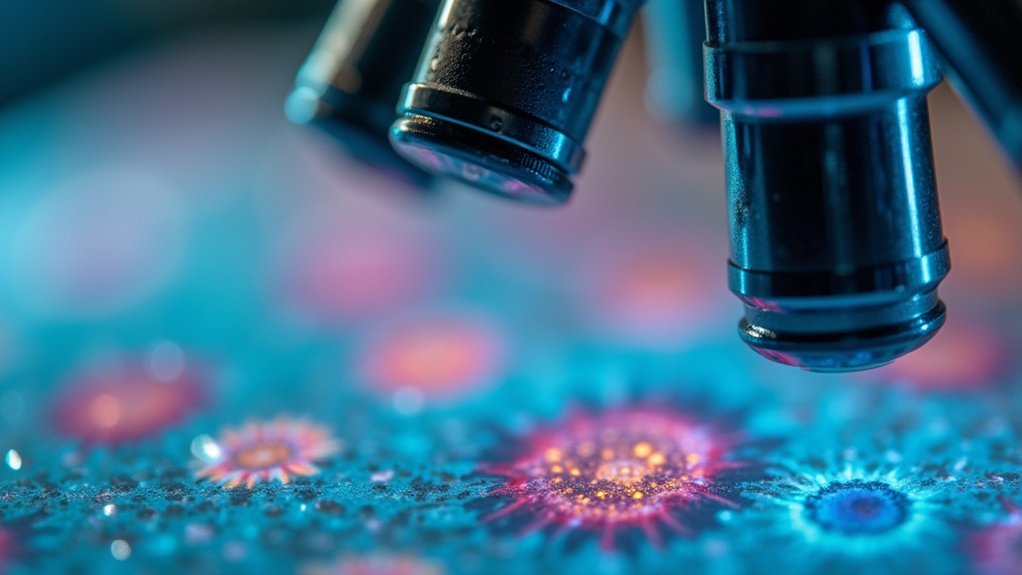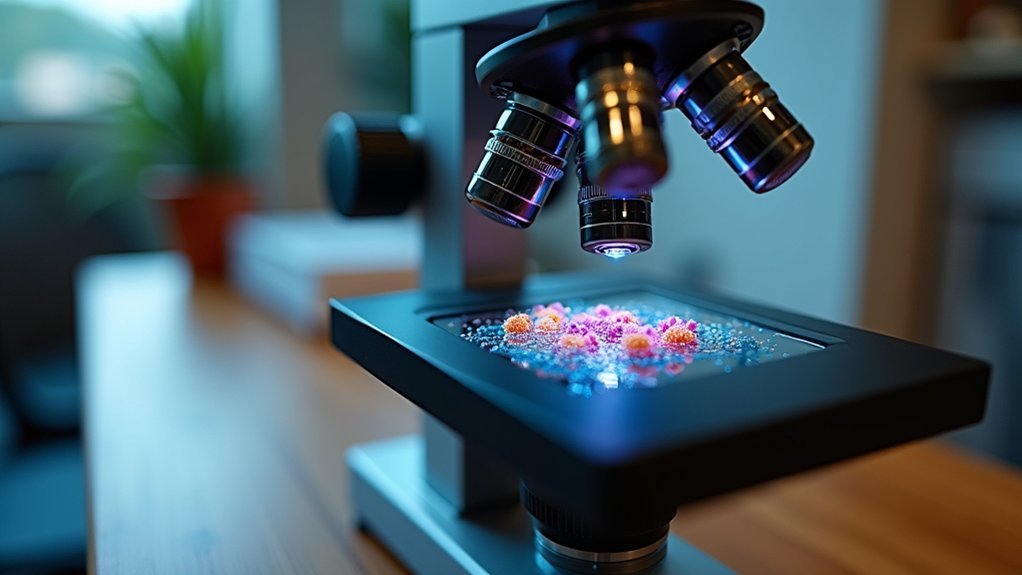To get crystal-clear microscope photos, avoid exceeding 1,800x magnification to prevent empty magnification where images appear larger but blurrier. Match your magnification to your specimen’s features and your optical system’s capabilities. Balance higher magnification (which shows more detail) with field of view (which shows more area). Your most impressive microscope images will come from finding this sweet spot rather than cranking up to maximum power.
Understanding Proper Magnification Ratios for Digital Microscopy

While many microscope users focus primarily on achieving the highest possible magnification, understanding the proper ratios between magnification and resolution is essential for quality digital microscopy.
Remember that total magnification comes from combining eyepiece, objective, tube factor, and camera sensor specifications. However, pushing beyond 1,800x often results in empty magnification—where you’ll increase image size without revealing additional details.
For best photographic results, consider your effective viewing distance on monitors, which requires angular differences of 2.3-4.6 minutes of arc for clear detail perception.
Your camera sensor dimensions directly affect your field of view, creating a rectangular object field determined by the smaller sensor dimension.
Balance your magnification desires with resolution capabilities to avoid the disappointment of larger but blurrier images.
Balancing Resolution and Field of View in Microscope Photography
Because microscope photography involves inherent tradeoffs, you’ll need to strike an ideal balance between resolution and field of view. Higher magnification reveals more detail but narrows your observable area, while lower magnification expands your field but sacrifices resolution clarity.
| Magnification | Resolution | Field of View |
|---|---|---|
| Low (<100x) | Limited | Expansive |
| Medium (100-400x) | Balanced | Moderate |
| High (>400x) | Excellent | Restricted |
When using digital cameras, remember that magnification beyond 1,800x often produces “empty magnification” with no additional detail. Calculate your object field by dividing the eyepiece field number by your total magnification. For effective imaging, match your magnification to your specimen’s features while considering your viewing distance and monitor specifications to achieve ideal microscope photography results.
Avoiding Empty Magnification: When More Is Actually Less

Understanding the principle of empty magnification stands as a fundamental concept for microscope users seeking ideal image quality. When you push magnification beyond 1,800x without gaining additional detail, you’re simply creating larger, less informative images.
You’ll achieve better results by maintaining balance between magnification and resolution. Remember, resolution—the smallest distance between distinguishable points—must be sufficient to support your chosen magnification level.
Without adequate resolution, high magnification produces blurry images that obscure fine details rather than revealing them. Consider your viewing distance too, as this affects perceived clarity.
Before increasing magnification, verify your optical system can actually resolve the details you’re hoping to see. Evaluate your microscope components and specimen characteristics to determine the best settings that enhance image quality without falling into the empty magnification trap.
Frequently Asked Questions
How Do You Get a Clearer Image on a Microscope?
You’ll get clearer microscope images by ensuring proper lighting, using quality optical components, implementing image stacking techniques, maintaining a stable setup, and regularly cleaning your optics and slides to prevent dust interference.
What Are the 3 Levels of Magnification on a Standard Microscope?
Your standard microscope offers three magnification levels: low power (10x), medium power (40x), and high power (100x). When combined with a 10x eyepiece, you’ll achieve total magnifications of 100x, 400x, and 1000x respectively.
How Do You Take Good Pictures With a Microscope?
You’ll need stable mounting, proper lighting, and calibrated settings. Mount your DSLR with an adapter, use consistent illumination, and try focus stacking for depth. Process images afterward with specialized software for best results.
What Magnification Do You See the Brightest Image?
You’ll see the brightest images at lower magnifications, typically 10x to 40x. This range allows more light to reach your sample without sacrificing resolution, especially when using quality LED illumination in bright field microscopy.
In Summary
You’ll get the best microscope photos when you match magnification to your specimen’s details. Remember to balance high resolution with adequate field of view, and don’t push magnification beyond what reveals new information. By following these three principles, you’ll capture clearer, more meaningful images and avoid the common pitfall of empty magnification that only introduces blur without added detail.





Leave a Reply